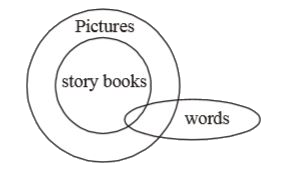In questions below, some statements are given followed by three/two conclusions/assumptions respectively. You have to consider the statements to be true even if they seem to be at variance from commonly known facts. You have to decide which of the given conclusions/assumptions if any, follow from the given statements.
Statement : Pictures can tell a story. All story books have pictures. Some story books have words.
Conclusions: I. Pictures can tell a story better than words can.
II. The stories in story books are very simple.
III. Some story books have both words and pictures.
Only conclusion I follows
Only conclusion II follows
Only conclusion III follows
Both conclusions I and II follow
The correct Answer is:C

Conclusions : (a) False
(b) False
(c) True
(d) False
Similar Questions
In the question, two statements are given, followed by two conclusion, I and II. You have to consider the statements to be true even if they seem to be at variance from commonly known facts. You have to decide which of the given conclusions, if any, follows from the given statements.
Statement1: All boots are sneakers.
Statement 2: All sneakers are shoes.
Conclusion I: Some shoes are boots.
Conclusion II: Some sneakers are bootsView SolutionIn the question, two statements are given, followed by two conclusions I and II. You have to consider the statements to be true even if it seems to be at variance from commonly known facts. You have to decide which of the given conclusion, if any, follow(s) from the given statements.
Statement 1: All storms are cyclones. Statement 2: All cyclone are tornadoes. Conclusion I: Some tornadoes are storms. Conclusion II: Some cyclones are storms.View Solution
Knowledge Check
- Question 1 - Select One
In each of the following questions, some statements are given following by three/ two conclusions/assumptions respectively. You have to consider the statements to be true even if they seem to be at variance from commonly known facts. You have to decide which of the follow from the given statements.
Statements : Pictures can tell a story. All story books have pictures. Some story books have words.
Conclusions:
I. Pictures can tell a story better than words can.
II. The stories in story books are very simple.
III. Some story books have both words and pictures.AOnly conclusion I followsBOnly conclusion II followsCOnly conclusion III followsDBoth conclusions I and II follow - Question 2 - Select One
In this question some statements are given. You have to consider the statements to be true even if they seem to be at variance from commonly known facts. You have to decide which of the given conclusion, if any, follows from the given statement.
All men are mortal.
Ramu is a man.ANo man is mortalBRamu is mortalCRamu is immortalDAll men are immortal - Question 3 - Select One
Two statements are given, each followed by two Conclusions/Assumptions I and II. You have to consider the statement to be true even if they seem to be variance from commonly known facts. You have to decide which of the given conclusions/assumptin, if any, follows from the given statements.
Statements :
(i) Some papers are pens.
(ii) All the pencils are pens.
Conclusions :
I. Some pens are pencils.
II. Some pens are papers.AOnly II Conclusions followsBEither I or II followsCBoth I and II followsDOnly I Conclusion follows
In the question, two statements are given, followed by two conclusions, I and II. You have to consider the statements to be true even if it seems to be at variance from commonly known facts. You have to decide which of the given conclusions, if any, follow(s) from the given statements.
Statement I: No ties are bows.
Statement 2: All bows are silk.
Conclusion I: some ties are silk.
conclusion II: Some silk are bows.View SolutionIn the question two statements are given followed by two conclusions, I and II You have to consider the statements to be true even if it seems to be at variance from commonly known facts. You have to decide which of the given conclusions, if any, follows from the given statements.
Statement I: All tickets are coupons
Statement II : All cards are tickets
Conclusion I: Some coupons are cards
Conclusion II: Some cards are coupons .View SolutionIn the question two statements are given, followed by two conclusions, I and II. You have to consider the statements to be true even if it seems to be at variance from commonly known facts. You have to decide which of the given conclusions, if any, follows from the given statements.
Statement I: No books are notebooks
Statement II: All diaries are books
Conclusion I: No notebooks are diaries
Conclusion II: All diaries are notebooksView SolutionIn each of the following questions one/two statements are given followed by two conclusions and assumption (I) and (II). You have to consider the two statements to be true even if they seem to be at variance from commonly known facts. You have to decide which of the given conclusions and assumption, if any , follow from the given statement.
Statements :
All hens are cocks.
No cock is black.
Conclusions :
I. All cocks are hens.
II. No hen is black.View SolutionIn the question two statements are given, followed by two conclusions, I and II. You have to consider the statements to be true even if it seems to be at variance from commonly known facts. You have to decide which of the given conclusions, if any, follows from the given statements.
Statement I: Some clouds are fog
Statement II: All clouds are mist
Conclusion I: Some fog are mist
Conclusion II: All mist are fogView Solution
